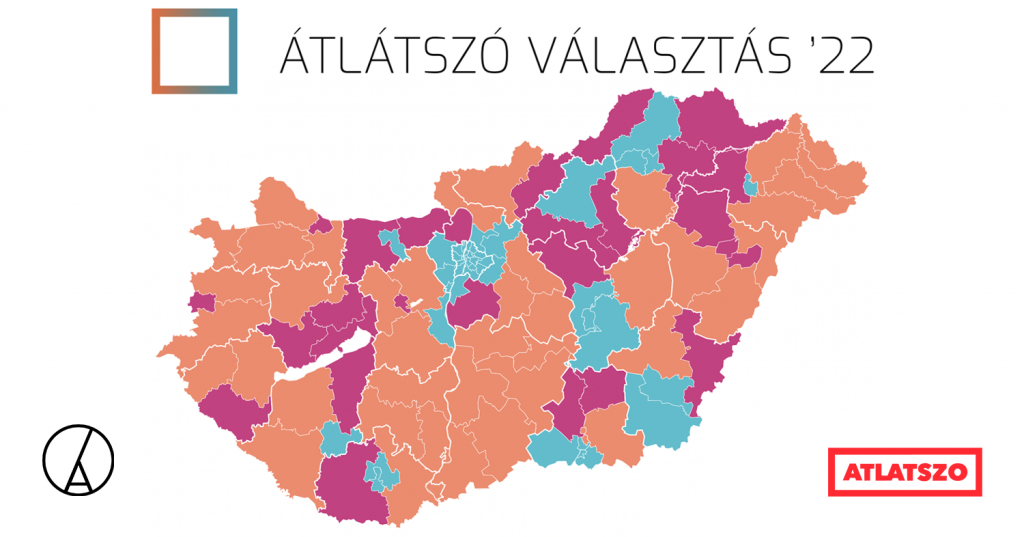The https://english.atlatszo.hu use cookies to track and profile customers such as action tags and pixel tracking on our website to assist our marketing. On our website we use technical, analytical, marketing and preference cookies. These are necessary for our site to work properly and to give us inforamation about how our site is used. See Cookies Policy
Hungarian parliamentary election 2022 – Maps and charts about the final results
The Hungarian parliamentary elections were held last Sunday, on 3 April. Átlátszó has been following the whole process from the beginning, and at the election day, we first showed the turnout, then the final results in maps and charts, after the votes were counted.
The Hungarian national election was held on April 3, 2022, the incumbent Prime Minister Viktor Orbán and his party (Fidesz-KDNP) faced a six-party opposition coalition (DK, Jobbik, LMP, MSZP, Párbeszéd) that has selected conservative politician Péter Márki-Zay as its joint candidate for prime minister during the opposition primaries held in 2021.

Despite opinion polls showing a close race, Viktor Orbán’s right-wing Fidesz party won a fourth consecutive term, taking two-thirds of seats in the National Assembly.
On Atlatszo, we documented in detail the events and results of the primaries, from the collection of recommendations to the second round.
Last year, we categorised the electoral districts in terms of the chances based on past results, and also produced several compilations per district, monitored the collection of recommendations – documenting the cases of forged signatures – and analysed how an election can be interpreted in the Hungarian political system, which academic publications classifies as a hybrid regime that is, in the grey zone between democracy and autocracy. Finally, we showed which electoral districts to look out for on election day, and mapped the growth of the governing party (Fidesz) in the previous cycle.
Based on the results, our data team, Atlo created a subpage dedicated to the election.
In addition to the final results, the site also showed the preliminary results announced during the day on regularly updated graphs and maps. In addition to the votes cast for individual constituency candidates, the figures for the national list seats are also clearly visible in our charts. We mapped the participation data and priced the data separately by type of settlement, compared to the turnout in 2018.
Besides the traditional charts, showing for example how many votes were cast for each party, and exactly which county was won by which contestant, this time wecreated several new charts and chart pairs too.
The full election site serves as a database of parliamentary elections from 2006 until now (with downloadable data). The site contains more than 300 different maps, as well as the same number of graphs and charts.
On the day of the election, a “child protection” referendum was also held in Hungary. In June, a new amendment was submitted to the child abuse law by MPs of the Prime Minister’s party in Hungary which basically banned the „promotion and representation of sexual minorities.”
Hungary’s new anti-LGBT law is mostly about the upcoming elections
On 10 June, a new amendment was submitted to the long awaited child abuse law by MPs of the Prime Minister’s party in Hungary which basically banned the „promotion and representation of sexual minorities.” The recent changes have caused both national and international outcry.
After the law was passed, the Orbán government announced that a referendum with 4 questions would be held on child protection. NGos urged invalid votes, saying that its approval would strengthen prejudice against the LGBTQ community. We have also presented the turnout data for the referendum on various graphs, covering municipal, county and national data.
Our data visualisations about the Hungarian election are available here:
Átlátszó választás ’22 – 2022-es eredmények
Az Átlátszóra készített, 2021. augusztus 4-i elemzésünkben bemutattuk, hogy mely választókerületek számítanak valószínűleg vagy biztosan ellenzékinek, valószínűleg vagy biztosan Fideszesnek és melyek azok az úgynevezett csatatérkörzetek, ahol a szoros eredmény miatt nehéz eldönteni, hogy ellenzéki vagy Fideszes lenne a választókerület.
Hungary. What do you know about Hungary? from atlatszo.hu on Vimeo. „”


